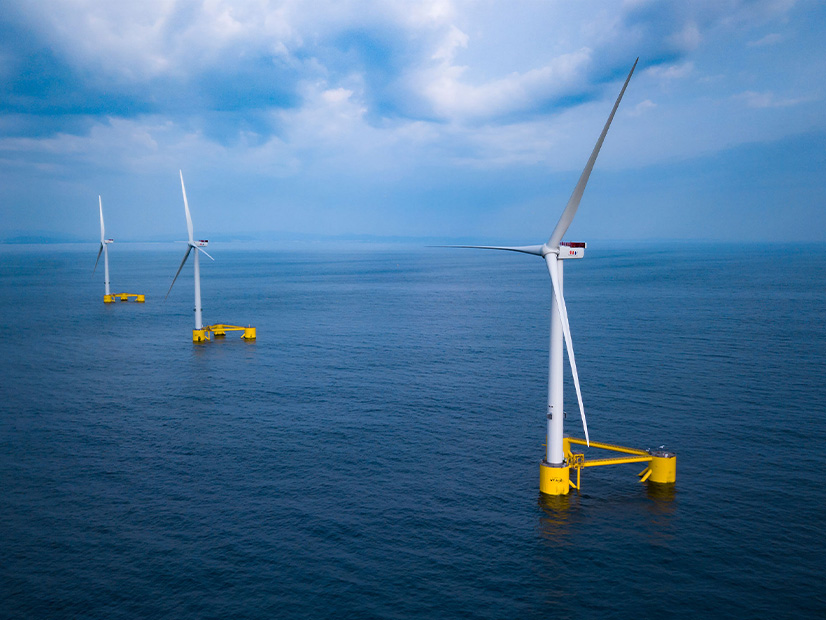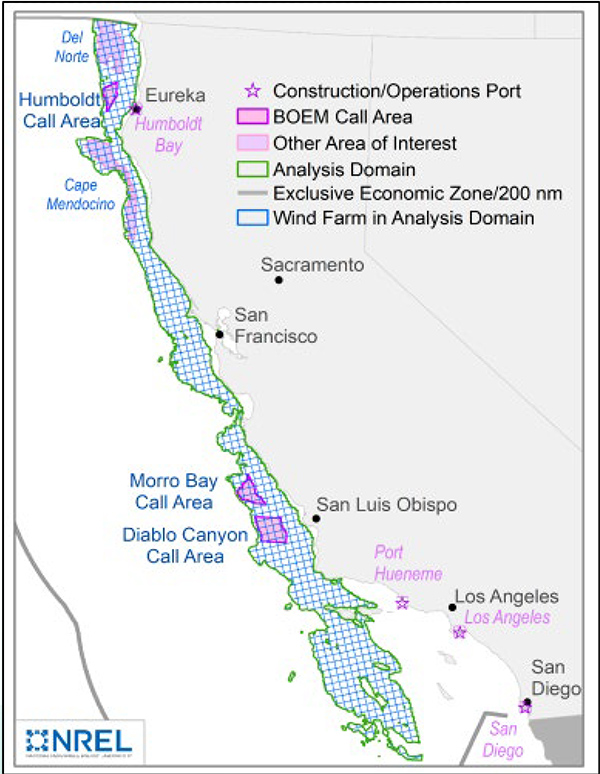
The mood was almost euphoric Wednesday as the California Energy Commission adopted the nation’s most ambitious long-term offshore wind goals, targeting a buildout of up to 5 GW by 2030 on the way to 25 GW by 2045.
The CEC approved the targets about a week after it released an updated draft report proposing to sharply increase earlier proposed goals of 2 GW by 2030 and 10 to 15 GW by 2045, which critics — including Gov. Gavin Newsom — contended were too conservative. (See California Boosts Offshore Wind Goals.)
Wednesday’s vote approved a final version of the report with the higher goals, which drew only praise from commenters at the commission’s monthly business meeting. Those speakers included labor representatives, members of environmental and community groups, students, a retired U.S. Navy admiral and a former state lawmaker.
“I think I share a belief that we all have that, in the future, we will look back to this moment, as you adopt this report with its recommended goals, as a critical milestone in our efforts to combat climate change,” said David Chiu, the former California assemblymember who drafted last year’s Assembly Bill 525. The law requires the CEC to “quantify the maximum feasible capacity of offshore wind” off the state’s coastline and set planning goals for 2030 and 2045.
“This is a momentous day,” said Commissioner Kourtney Vaccaro, the lead commissioner for the state’s offshore wind efforts. “I’m really excited. I wholeheartedly support approval of this report. And I am all in to do all of the work that needs to be done, because this is foundational. It’s a milestone.”
 NREL has identified five promising areas for wind development off the coast of California. | NREL
NREL has identified five promising areas for wind development off the coast of California. | NRELCEC Chair David Hochschild — who opened Wednesday’s meeting by lauding the “amazing event” Sunday when the U.S. Senate passed the Inflation Reduction Act (IRA) — said the adoption of the offshore wind goals was part of a “trifecta year for us” that will include the signing of the IRA and this fall’s first California OSW lease auction by the U.S. Bureau of Ocean Energy Management (BOEM). (See Senate Passes Inflation Reduction Act.)
BOEM this spring issued a proposed sale notice for five lease areas off the California coast, with auctions expected this fall for the Humboldt Bay and Morro Bay areas.
Commission Vice Chair Siva Gunda pointed to two key technical benefits that offshore wind will provide to a California grid increasingly reliant on intermittent solar resources.
“One is the load shaping it offers and the capacity factor that it offers, which is incredibly important for balancing the grid, but also in our opportunity to retire fossil assets as quickly as we can,” Gunda said. “So I think it’s an important element of the overall piece, and diversity [of resources] is critical.”
“This is one of the big pieces of clean, kind of firm power in a way,” Commissioner Andrew McAllister said. “Not quite in the sort of traditional definition, but it’s a great constant resource that’s predictable, and so it is a big piece of the puzzle that’s actually taking shape.”
Reshaping Communities
McAllister also pointed to the potentially transformative impact of a growing offshore wind industry on California’s economy, especially in struggling coastal communities.
“If you just envision what that is going to look like, in practical terms, for our economy, for our workforce … this is just a huge, huge endeavor that’s going to have all sorts of benefits for the state, and it’s going to reshape communities,” he said.
The economic and employment impact of offshore wind was a recurring theme in public comments during Wednesday’s meeting.
“When we first proposed AB 525, I said that we had already seen a preview of the future havoc that climate change will wreak in the form of heat waves, wildfires, droughts [and] rolling blackouts, and that we have a once-in-a-generation opportunity to transition to a new clean and green society in a way that could put thousands of Californians into high-skilled, well paying jobs,” said Chiu, currently the city attorney for San Francisco.
“We’re really impressed with the progress that the state is making towards offshore wind, not just for its impact on the transition to clean energy, but for its impact to labor,” said Larissa Petrucci, a research analyst with joint labor-management group NorCal Construction Industry Compliance. “As we move to a clean energy economy, we really want to see those skilled and trained workers build the machines that will move us to 100% clean energy. We want jobs that we can be proud of, and this is exactly what the offshore wind energy will provide.”
And while the CEC calls for 3 to 5 GW of floating offshore wind by 2030, Petrucci and other labor representatives called for the state to aim for the higher end of that range.
Speaking for the California State Building and Construction Trades Council, Mark Mulliner said the Humboldt area is a “desolate place” after the loss of jobs stemming from the closure of lumber mills.
“The best opportunity is what you guys are looking at approving,” Mulliner said, adding that the OSW industry will be a “huge part of changing the environment and changing the work environment for Humboldt and for the local communities.”
Trevor Zierhut, of LiUNA Local 585 in Ventura County, said the state is “facing a unique opportunity with determined stakeholders all working towards a common goal and the federal government actually moving forward at an unprecedented pace on this issue.”
But he cautioned that state officials should not neglect the need for new transmission to handle OSW output.
“If we aren’t planning big on transmission, we’re only doing half the work necessary to make the changes we all want to see,” Zierhut said.
Retired Adm. Dennis McGinn posed the state’s OSW efforts as a way to shore up the nation’s energy, economic and environmental security and quality of life. “California has the opportunity to seize this wonderful asset offshore as former [Assemblymember] Chiu outlined, and it is there for the taking.”
McGinn added that, as the former commander of the U.S. Third Fleet involved in operations off the California coast, “it is compatible to have military operations in training and offshore wind, producing great clean energy in a complimentary way.”
University of California, Merced student Cassandra Boyce delivered an emotional plea encouraging state officials to “go big” with offshore wind.
“We’re facing a climate crisis, and the only way we can solve it is to stop burning fossil fuels. I know that the goal of [over] 20 GW by 2045 is really going to support that movement towards a future that won’t just be clean, but healthy,” Boyce said.



